The Islamic Decorative Patterns and their Reflectionson Vasarely’s Paintings
Main Article Content
Abstract
This research is concerned with studying Islamic decorative Patterns and their reflection in Vasarelypaintings. The research was divided into four chapters. The first chapter was devoted to explaining the research problem، its importance، need،purpose، and limitations، and defining terms contained therein. The research problem dealt with the topic of studying Islamic decorative Patterns and their reflection in (Vasarely)paintings Which is summarized by the following question: How was the influential vision of the artist (Vasarely) in Islamic art formed، and what distinguished the artistic reflection in his paintings? What is the reflection of the coordination and aesthetic that witnessed through his artistic paintings? The second chapter included two topics، the first concerned with (an introduction in the decorative Patterns of Islamic art)، and the second concerned with (coordinate transformations in European art) This chapter included a presentation of the theoretical framework indicators and previous studies، and the third chapter included research procedures، while the fourth chapter focused on the results and conclusions of the research
Firstly: the results
- Vasarely paintings in its references depended on sequential Islamic decorative Patterns through the sequential decorative pattern similar to the Islamic decoration pattern in terms of the repetition of circular motifs and the use of these forms، through its visual impact affected by Islamic decoration and behind visual forms bearing connotations from the human depth of art.
- (Vasarely) borrowed in his artistic treatments some of his paintings drawn forms or symmetries from the works of art of Islamic civilization، which gives the figure a wonderful circular pattern with a regular circular rhythm indicating its close association with Islamic civilization and decorative art، relying on the distortion in space and away from the traditional perspective to draw from it What renews his artistic and aesthetic vision.
Secondly: the conclusions.
1- That the artist (Vasarely) was influenced in his paintings by Islamic arts، because he found in them a source of inspiration for the human self، so he sought life، reduced to form and excluding everything that surrounds reality directly.
2-The vision of (Vasarely) revolves around the creation of forms، configurations، and artistic treatments in imagined subjective worlds that are far from simulation and are the essence of awakening surprise to the recipient when reading artwork in a new formulation of art in treatments with multiple formats.

